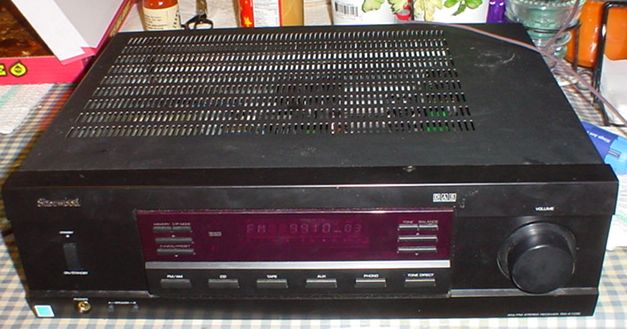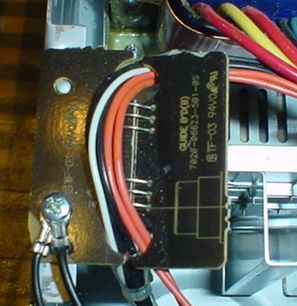
Sherwood RX-4109 / Insignia
NS-R2000
Take Apart and Teardown
Sherwood
has a huge business in the
manufacture of audio equipment for others. As of this writing, that
includes most of Pioneer's receiver product line (go ahead and look
if you don't believe me, especially at some of Pioneer user's guides)
as well as the stuff
sold with Best Buy's Insignia
brand printed on it.
Both of them cost more than what I wanted to spend, so I turned to eBay and found the Best Buy unit being sold new in box at a very low price from a seller not all that far from my location. The reviews were good and a cursory examination of a shelf demonstration unit's internals suggested it was at last passably well built.
The RX-4109 doesn't have reviews that are anywhere near as good as its Insignia counterpart. There are countless reports of people blowing them up in some way or another, sometimes only after a short period of time. As I said in my original review, there could be a few reasons for this: the receiver could be badly designed, users could be doing things they should not, or the users could just be ignorant. So that you won't think I'm leading you on in the (misguided?) hope that you will read this whole article, I now believe that all three possibilities are factors that might lead to this receiver's untimely demise. By itself, each one is minor—but if you add them all up, the end result may be a failed unit.
You'll
note that some reviews show there to be no middle ground here. People
either like this receiver or hate it.
This page aims to show you what is inside each receiver so you can make your own decision. I didn't want to descend on my new, working unit with tools, so I scoured eBay again and came up with an RX-4109 that was listed as able to power on but not working otherwise.
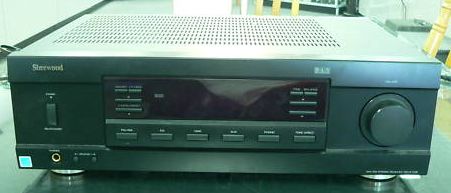
It cost
$30 to purchase and ship it.
I've spent more and gotten less, and the fact that it powered on
suggested things weren't all that hopeless. $30 for an evening's
worth of entertainment didn't seem too bad. Watching TV usually costs
less, yet
I'd admit that the internals of a stereo receiver are much more
interesting than most of what's on the tube these days. If I got a
working stereo receiver out of the deal, even better!
What
wasn't so entertaining was waiting
nearly a month
before said
receiver FINALLY darkened my doorway.
Oh
well. I put the
receiver on the kitchen table and plugged it in. Indeed it did power
on. First the main power relay clicked, followed by the speaker
protection relay, just as my working NS-R2000 receiver does. Okay,
that's even more promising.
These
units have
speaker switches that let you select no, A, B or all speakers. I
wonder...surely it couldn't
be that simple?
I
rummaged around
and found some crappy car speakers with detached surrounds and crazed
plastic cones. If the amplifier blew these up, it would be no loss. I
pressed speaker switch A. There was a satisfying click¹ from
the relay
inside.
The
audio came on
perfectly as soon as I had tuned a station and put my finger against
the antenna input. What a pleasant surprise.
I like to think that those companies who say “90% of units returned are in fine working order” are exaggerating but it's stuff like this that makes me wonder if we're not all doomed.
What the heck, I bought it to take apart, and that's exactly what I'm going to do. (Some of the pictures here are clickable, so you can see them in a larger size.)

Popping the cover gives a clearer look at some things you can already see. There is a decently sized power transformer, two moderately sized filter capacitors and a largely empty circuit board with lots of wire shunts running over it.
The internals are pretty clean and straightforward, although there are a few artifacts and interesting structures. A lone empty socket awaits some kind of connection to be made, probably with a daughtercard of some kind. Over by the power switch, wiring runs through a sort of “bridge” circuit board that appears to do nothing other than help route the wires. This board is grounded, so perhaps it is some sort of a choke or an attempt at limiting noise.

Another connector has a daughtercard in place that provides the phono connnectivity. This, two jumper straps on the main board and a front panel button are probably the only things to separate the phono-input equipped RX-4109 from the phono-input-less RX-4105.
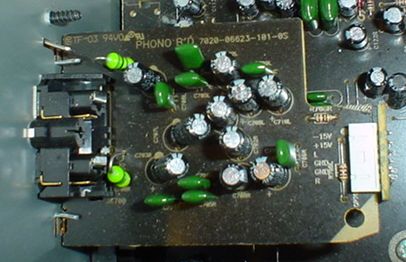
The power amplifier's heatsink is curiously situated. Although there is ample space for incoming cool air to come up through the bottom of the unit, the heatsink is situated such that heated air coming off of it cannot easily escape. In other words, there are no holes in the top cover directly above the heatsink. Furthermore, there also isn't much of a heatsink. I've seen heftier heatsinks in amplifiers with lower power ratings. Surely this could have been put further back on the circuit board to facilitate a larger heatsink and more airflow?
This is not the best design I've ever seen. It could aggravate any occurrence of overheating.. I saw at least one report of someone putting a fan behind the heatsink to help the power transistors stay cool. There is plenty of space to do exactly that, as a large gap separates the front panel board from the rear of the heatsink. An AC muffin fan could be wired in without undue difficulty. The power relay could be used to turn such a fan on, or if you were really feeling clever, I suppose some kind of thermal system could be used. I think Sherwood was definitely a bit on the stingy side with their heatsink.
If people who bought these receivers have indeed done such brainy things as connecting two pairs of four ohm speakers (for an effective resistance of just two ohms when everything is playing at once!) to the amplifier, then I'm not too surprised to hear of its failure. With cooling like this, even a four ohm load is probably on the edge for this unit, especially at higher volume levels.
The
back of the
control board has an IC on it. In later revision receivers, this is a Silan Microelectronics
(website was down, it seems to be back now 05/2010)
SC16315 display driver with multiple dimming level
support. That is the only
function it performs, so the system controller must be somewhere
else. Where is it? It's not on the control board or the mostly empty
main board. On the ribbon cable leading from the display, there are
volume control lines, voltage lines for the IC and display panel, a
few grounds and a serial data link that goes somewhere. Earlier
receivers used a Sony microcontroller situated on the display board.
Most of the rest of the circuitry appears to be the same between the
two. It's unclear when this change took place, but if you know, please
do contact me.
I still didn't see much of anything that looked like a system controller on the other side of the board. There is a Sanyo volume, balance and tone control IC (to the right in the picture above), a very small IC whose printing I could not clearly read (it looks like a serial EEPROM though I did not trace the circuit to see if that makes sense), and an NEC uPD502T (to the upper left in the picture above).
(Whoops. I forgot to take a high resolution picture of the whole board. Oh well.)
The
system controller is the NEC IC...it's an off-the-shelf 8-bit
microcontroller belonging to their 78K series of products. Although
"uPD502T" is all that's printed on the IC, its actual part number is
quite different and will show up here as soon as I check the Sherwood
service manual.
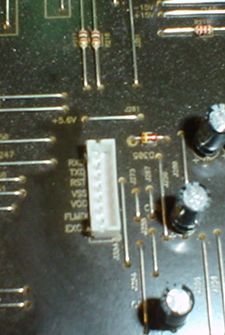
Based
on pin names
and some random assumptions, it appears that this
unused but populated connection would have an RDS decoding circuit
put into place for receivers that have RDS display capability (sadly,
none sold in the US market are equipped for this). I have never
understood why this is—RDS is used in the US market on some
FM
stations. The cost difference between receivers that have the decoder
and those that don't must be negligible.
I'd like to get an example of the RDS decoder board to see what's on it. If anyone has one, please, please write me an e-mail! Sherwood America wouldn't sell or send me one.
Now for the power amplifier section, or at least the transistors that make it up. The major components are 2SD1510 and 2SB2510 transistors. Of those, some studying revealed that the 2SD1510 part is said to cross reference to an NTE261. There isn't a direct cross for 2SB2510 part that I could find, but the two NTE transistors are complementary, and the complement to an NTE261 is an NTE262.
I'm not deeply familiar with the technical details of how audio power amplification works, nor do I know precisely to what class this amplifier's design belongs, but it's my belief that this amplifier design could come close to the advertised power ratings of 105 watts/channel RMS into an eight ohm load. It looks to be a push-pull design, so it will be a class B or AB amplifier--I haven't yet determined which. (Class A push-pull audio amplifiers are not an impossibility, but this page shows you why one would be very impractical.) A 65W power dissipation figure per transistor is specified in the NTE261 (and 262) datasheet, and each one will share the burden of driving the load so it seems reasonable to me when they are paired.. (Yes, I'm using the NTE part ratings, as ratings for the parts Sherwood used don't seem to be directly available. At least I could not find them.)
Interestingly, the volume dial goes up to a maximum of 62 (63 if you count the "MAX" reading.) I wonder what the calibration and units are? There's a "db" indicator in the display but it is not used.
If I'm totally off-base here, a (polite!) correction would be more than welcome. And if anyone would like to provide a better explanation than my own limited understanding can supply, I'd greatly appreciate it—even more so if you'd be willing to let me reproduce it on this page. Write me here.
The Front Panel
I realized only after tearing the receiver apart once that I'd totally forgotten to talk about the front panel in any meaningful way. The only thing I'd said anything about was the display driver IC, and that was that.



Well, that's really about all there is to to this thing. I was curious, so I took it apart and reported on findings with some photos thrown in for a bonus. I think that Sherwood could have implemented a better cooling system for their power amplifier—and that if they had, it would probably better tolerate or even survive the connection of speakers that presented only a four ohm resistance to the amplifier. (Those who connect two pairs of four ohm speakers to this receiver are on their own. That would result in only two ohms resistance, and I've never seen a stereo receiver that claimed it could safely operate at such low resistances.)
I can say that I did finally try operating four speakers at once with this receiver. One set consisted of two Boston Acoustics bookshelf speakers and the other set were some impressively expensive Wharfedale Modus 8 speakers. Not only were all of these speakers Very Definitely Unwisely Loud with the volume turned up, but the receiver never skipped a beat while driving them at high volume levels. I'm beginning to think that some of these units are dead in the box or that people are doing things they shouldn't, or things that they would not do if they understood the repurcussions of their actions. Even with the volume cranking (44 out of a maximum of 63 on the dial) the amplifier didn't break a sweat with an ambient temperature of some 71 degrees Fahrenheit.
There are some curious differences between the RX-4109 and Best Buy's NS-R2000. The most notable of these is the ability to control every receiver function from the front panel on the NS-R2000. With the RX-4109, you cannot access some features from the front panel, such as the display dimmer. You must have the remote. Present on the NS-R2000 is a hard power switch that is not found on the RX-4109. Both units have a soft “standby” power switch.
And don't worry...no stereo receivers were harmed in the making of this web page, as you can see from the below picture, showing the once again assembled RX-4109 powered on and playing from its built in tuner. You'll have to look carefully, but the display is on. It's driving a pair of Boston Acoustics loudspeakers (not pictured).
All work was done on an ESD handling regulation compliant kitchen table. The blue carpet in the Roach Palace is also an ESD handling regulation compliant surface.
